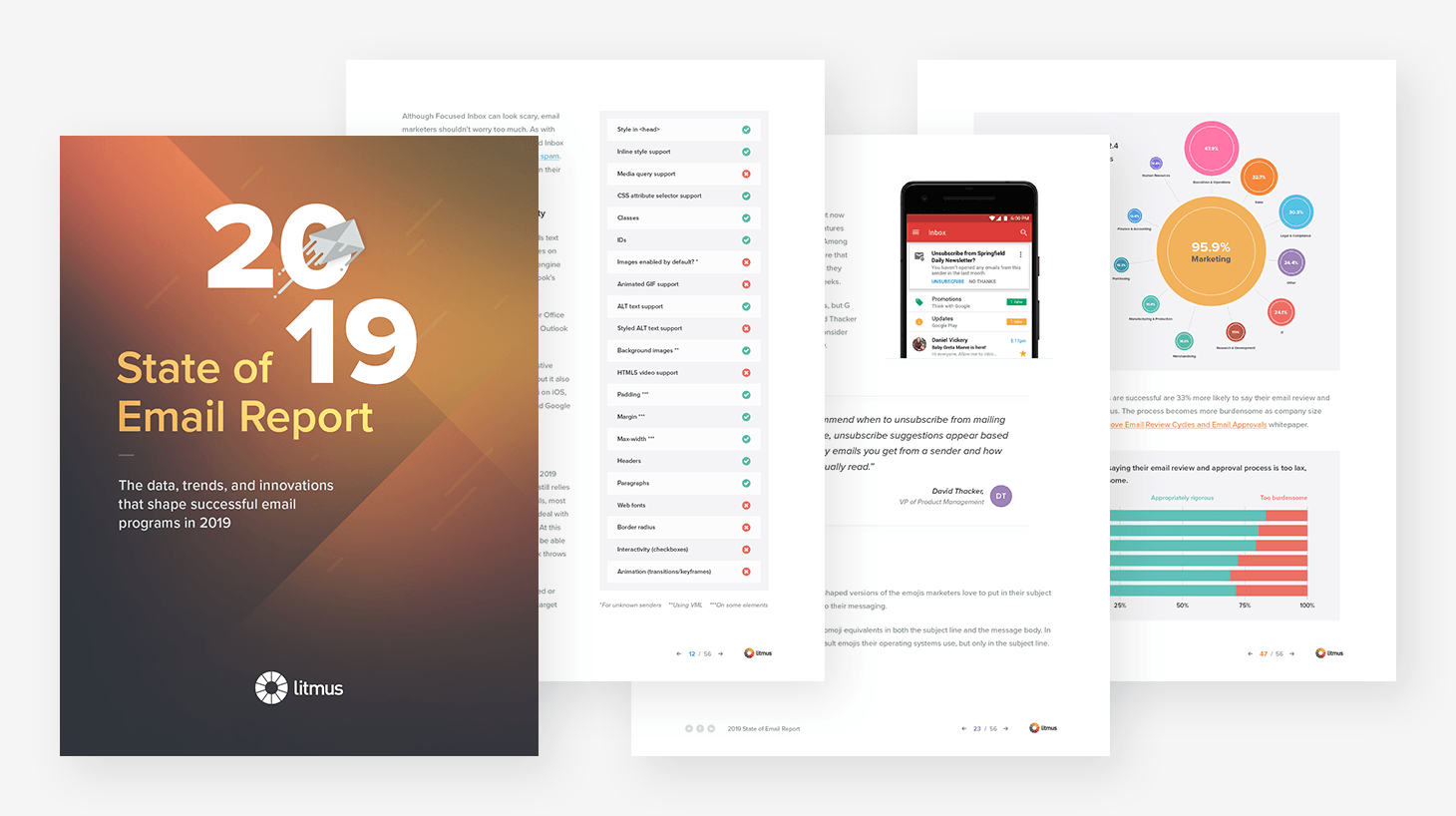Did you read Litmus’ full annual State of Email report?
It’s 56 pages of pure email marketing gold, but we know that time doesn’t grow on trees for agency owners and marketers.
Which is why we’ve put together this handy summary for you. Think of it as the abridged version of the Litmus’ State of Email report for 2019 for busy professionals: you’ll still get most of the meat, without having to read through every page (but we recommend that you DO at some point!).
You’ll see in the paragraphs to follow that there were some pretty significant changes in the world of email over the past 12 months. While the report has a number of amazing insights into how we communicate electronically, here are the six most important tidbits we uncovered.
Behind-the-Scenes Improvements
There were a number of behind-the-scenes improvements made by email service providers in 2018. While the Litmus report goes into much more detail, here are some of the more significant changes:
- Google announced the rollout of Accelerated Mobile Pages (AMP) capabilities for Gmail, noting that the technology would be free for other providers to adopt as well.
- Yahoo Mail became the first service to test the Brand Indicators for Message Identification (BIMI) security standard.
- Oath (the parent company of Yahoo and AOL) announced that it would begin scanning emails received by all of its services for the purpose of targeted advertising.
- The European Union’s General Data Protection Regulation (GDPR) went into effect, adding new obligations for data processors and controllers that do business with EU residents.
- Slack purchased the software company Astro in an effort to boost email functionality.
Client Overhauls
In addition to changes behind the scenes, several email clients received other overhauls as well.
Three of the largest email service providers were included in these overhauls, with big changes coming to Outlook, Gmail and Yahoo Mail. All three received new features including interface changes and improved security features, and some of the behind-the-scenes movements that these providers made were also part of this initiative.
For Outlook, this was a continuation of an overhaul that’s been going on for a few years now. It seems to be working, as Litmus found that Outlook had increased its market share to 10 percent of the total email market in 2018 between the Outlook client and Outlook.com. Gmail’s changes were more of a streamlining of features as it began rolling out AMP and other new technologies, with some features like the Inbox by Gmail sandbox being phased out as part of the revamp.
Interactivity in Email
More efforts were made to transform email into an interactive experience, allowing senders to not only add features such as live progress tracking and other dynamic elements directly into email bodies but also making email link usage much more seamless. Email clients are becoming more interactive as well, with many more providers embracing features such as inbox image previews, online attachment editing and live collaboration within the email environment itself.
Data Protection Concerns
With the number of significant data breaches occurring in recent years, Litmus found that a number of email providers were beefing up security to help protect your data in 2018. In addition to improved overall security for the email servers, client changes included tools to help authenticate senders to fight spam and help email recipients know that a message comes from a trusted source. The implementation of the GDPR prompted several other countries to pass similar data protection regulations, meaning that the improvement of email security is likely to continue in the coming years.
Continued Mobile Popularity
One significant reveal from the Litmus report is the extent to which mobile clients are dominating the email market, with a full 43 percent of all email opens occurring on mobile devices in December 2018. The Apple iPhone’s email client claimed 29 percent of the email market share, with Android clients and the iPad also ranking in the top 10. Services with easy mobile accessibility also ranked well, with Gmail claiming the number 2 spot in market share and Outlook coming in at number 4 (with additional market share specifically for Outlook.com at number 8).
This revelation is especially significant to marketers as it reveals just how important mobile-friendly marketing efforts really are. Gmail, Outlook and Yahoo Mail opens are all up since 2017, though in Yahoo’s case this is due at least in part to internal consolidations. Still, if your message isn’t accessible in the format people are using, then you’re not going to benefit from this increase.
Email Regulation Impact
The GDPR and other regulations affecting email had some marketers on edge, wondering how much of an impact they would have on legitimate marketing efforts as providers rushed to crack down on spam and scams. This is where the report had a bit of good news: Despite the rush for compliance, there doesn’t seem to be a significant negative impact on marketing efforts so far.
While some marketers may need to adjust some tactics if they were already operating a bit fast and loose, the majority of agencies will suffer few if any negative impacts from the changes that were made to email in 2018. In fact, some of the changes being made by providers may actually strengthen your efforts into 2019 and beyond.
And when you find the time, we highly recommend downloading the full report here.
